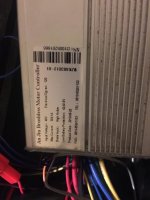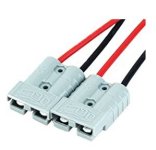KDKD
1 mW
- Joined
- Jul 29, 2020
- Messages
- 19
Been lurking here for a while and I'm finally in a position to be able to ask for help...
My Serengeti Panther scooter ran fine initially, and slowly the battery was dying sooner and sooner until one day when I had to walk the scooter home as my poor little champ could not even get me where I was going. I took the battery apart just to see what it looked like inside. Then I moved, but I could not take the scooter because it would not run, and I could not lift it by myself into my SUV. So it sat in my old condo complex for about 6 months.
Yesterday I got a call from a scooter repair place. Someone tried to steal it, couldn't get it to run, and ended up scamming the scooter shop. The shop owner unlocked the seat and found my registration paperwork and called me.
So now I (finally) have my scooter back, but the thief removed a bunch of the panels and I cannot tell what wires he took apart. I have a feeling I will be able to figure it out if I knew I had a working battery pack.
So here I am to ask a simple battery question to start ... I want to know if it is possible to buy a COTS 48V 15Ah rechargeable battery with a built-in BMS off the shelf, replace connector with a C13 connector, use my existing charger ... and basically just plug and play? I have never built a battery pack from scratch and I am already overwhelmed after the mess the thief made. I always loved this scooter. It was in pristine condition before the guy stole it and I'm not ready to let it go
(The guy at the scooter shop was super nice, but I read reviews and he can be really unreliable and I was not impressed with his work habits when I came by to pick it up, so I would rather just figure this out myself.)
If I could just start with a known good battery, I think I can get the scooter running. I know it's not the cheapest option but would buying COTS work?
My Serengeti Panther scooter ran fine initially, and slowly the battery was dying sooner and sooner until one day when I had to walk the scooter home as my poor little champ could not even get me where I was going. I took the battery apart just to see what it looked like inside. Then I moved, but I could not take the scooter because it would not run, and I could not lift it by myself into my SUV. So it sat in my old condo complex for about 6 months.
Yesterday I got a call from a scooter repair place. Someone tried to steal it, couldn't get it to run, and ended up scamming the scooter shop. The shop owner unlocked the seat and found my registration paperwork and called me.
So now I (finally) have my scooter back, but the thief removed a bunch of the panels and I cannot tell what wires he took apart. I have a feeling I will be able to figure it out if I knew I had a working battery pack.
So here I am to ask a simple battery question to start ... I want to know if it is possible to buy a COTS 48V 15Ah rechargeable battery with a built-in BMS off the shelf, replace connector with a C13 connector, use my existing charger ... and basically just plug and play? I have never built a battery pack from scratch and I am already overwhelmed after the mess the thief made. I always loved this scooter. It was in pristine condition before the guy stole it and I'm not ready to let it go
(The guy at the scooter shop was super nice, but I read reviews and he can be really unreliable and I was not impressed with his work habits when I came by to pick it up, so I would rather just figure this out myself.)
If I could just start with a known good battery, I think I can get the scooter running. I know it's not the cheapest option but would buying COTS work?





